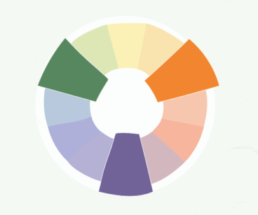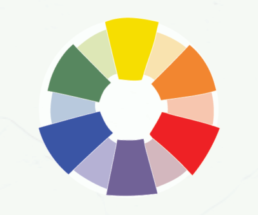Primary Colours
Colour WheelsArtists need to know their colours. If you would like to be an artist you need to know all
about how colours are made by mixing colours together.
Colours are often displayed on a COLOUR WHEEL to show how they are related.
Primary colours are the building blocks of all colours. From these three colours, along
with white and black, we can make just about all the colours we can think of by mixing
them together in different amounts.
The 3 Primary Colours
In art the three PRIMARY COLOURS are: RED, BLUE and YELLOW
A good way to remember why these colours are so special is that we can’t make these
colours by mixing other colours together. No matter how hard I try, I can’t mix red, I can’t
mix blue and I can’t mix yellow.
Black & White
Black and white are special. Technically they aren’t even called colours. Black and white
are used to make colours darker or lighter.
When we mix BLACK with a colour, that is called a SHADE
When we mix WHITE with a colour, that is called a TINT
When we mix both BLACK & WHITE (or GREY) with a colour, that is called a TONE
Are there other Primary Colours?
In art, we use what is called a Red, Blue, Yellow colour wheel. But in other areas different
colours are used as primary colours. For example in science or on your computer, a Red,
Green, Blue or a Cyan, Yellow, Magenta colour wheel may be used to describe how
colours are created.
More Information
To further your colour knowledge, don’t forget to read our other blogs on secondary,
tertiary and complementary colours. If you would like a print out of our colour wheel
posters, have a look on our website under RESOURCES > COLOUR WHEELS.
Here you will find printable colour wheels available in both English and U.S spelling.
Secondary Colours
Artists need to know their colours. If you would like to be an artist you need to know all
about how colours are made by mixing colours together.
Colours are often displayed on a COLOUR WHEEL to show how they are related.
Secondary colours are the next set of colours after our PRIMARY colours. SECONDARY
colours are created when we mix equal parts of 2 Primary Colours.
The 3 Secondary Colours
In Art, the three SECONDARY COLOURS are:
ORANGE, GREEN & VIOLET
How are they made?
> ORANGE: Red + Yellow
> GREEN: Yellow + Blue
> VIOLET: Blue + Red
But what about Purple?
Sometimes people call the Secondary colour made by mixing RED & BLUE as PURPLE.
The colour Purple is actually what is called a tertiary colour (A colour created by mixing
a primary with a secondary colour.) Another name for purple is BLUE-VIOLET.
More Information
To further your colour knowledge, don’t forget to read our other blogs on primary,
tertiary and complementary colours. If you would like a print out of our colour wheel
posters, have a look on our website under RESOURCES > COLOUR WHEELS.
Here you will find printable colour wheels available in both English and U.S spelling.
Tertiary Colours
Artists need to know their colours. If you would like to be an artist you need to know all about how colours are made by mixing colours together.
Colours are often displayed on a COLOUR WHEEL to show how they are related.
TERTIARY colours are the next set of colours after our SECONDARY colours. Tertiary colours are created when we mix a PRIMARY colour with an adjacent SECONDARY colour on the colour wheel.
The 6 TERTIARY Colours
In Art, the six TERTIARY COLOURS are: RED ORANGE, RED VIOLET, BLUE VIOLET, BLUE GREEN, YELLOW GREEN, YELLOW ORANGE
How are they made?
> Red Orange: Red Orange = Red & Orange
> Red Violet: Red Violet = Red & Violet
> Blue Violet: Blue Violet = Blue & Violet
> Blue Green: Blue Green = Blue & Green
> Yellow Green: Yellow Green = Yellow & Green
> Yellow Orange: Yellow Orange = Yellow & Orange
Don’t Forget!
When we say or write a TERTIARY colour’s name, we always say or write the PRIMARY colour first. For example we always use the name RED-ORANGE, not Orange Red.
But what about PURPLE?
Sometimes people call the Secondary colour made by mixing RED & BLUE as PURPLE. The colour Purple is actually what is called a tertiary colour (A colour created by mixing a primary with a secondary colour.) Another name for purple is BLUE-VIOLET. As well as PURPLE this colour is also sometimes know as INDIGO.
More Information
To further your colour knowledge, don’t forget to read our other blogs on primary,
tertiary and complementary colours. If you would like a print out of our colour wheel
posters, have a look on our website under RESOURCES > COLOUR WHEELS.
Here you will find printable colour wheels available in both English and U.S spelling.
Complementary Colours
Artists need to know their colours. If you would like to be an artist you need to know all about how colours are made by mixing colours together. You also need to know how colours work together and how you can use colours to grab the viewers attention or even help tell your story.
Colours are often displayed on a COLOUR WHEEL to show how they are related.
This colour wheel shows COMPLEMENTARY COLOURS. Complementary colours are pairs of colours that are opposite one another on the colour wheel. Another name for complimentary colours is OPPOSITE COLOURS.
There are many, many pairs of complementary colours but this colour wheel shows the most commonly known pairs.
What’s all the fuss about?
Artists often use complementary colours to grab the viewers attention. Our eyes love to see complementary colours together in an artwork. Vincent vanGogh was famous for his use of complementary colours. He would often team up complementary colours in his brushstrokes and his paintings to make them visually appealing. He loved to use purples and yellows or red and greens together to name but a few.
In your own artworks, you can use complementary colours together to do the same. In your next artwork, try placing a set of complementary colours next to one another. Watch as your artwork leaps from the page because of how you have used your new found knowledge on complementary colours.
Complementary Colours:
In Art, common pairs of COMPLEMENTARY COLOURS are: RED & GREEN, BLUE & ORANGE, YELLOW & VIOLET, RED ORANGE & BLUE GREEN, RED VIOLET & YELLOW GREEN, BLUE VIOLET & YELLOW ORANGE
More Information
To further your colour knowledge, don’t forget to read our other blogs on primary, tertiary and complementary colours. If you would like a print out of our colour wheel posters, have a look on our website under RESOURCES > COLOUR WHEELS.
Here you will find printable colour wheels available in both English and U.S spelling.




